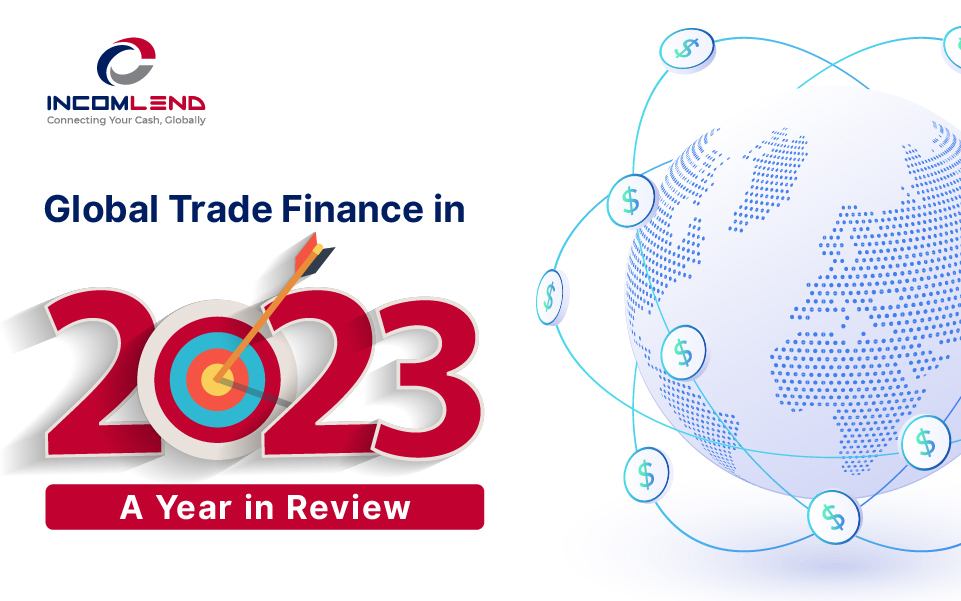Global Trade Finance in 2023: A Year in Review
December 12, 2023
As we say goodbye to 2023, it’s time to look on the significant features and trends that defined the global trade finance landscape. Geopolitical movements, technical improvements, and changing economic landscapes have all contributed to substantial changes in the realm of international trade. In this article, we’ll look at the important events that shaped global trade finance in 2023.
1. Digital Transformation Becomes the Centre of Attention
The rapid adoption of digital technologies in trade finance was one of the most visible trends in 2023. Blockchain, artificial intelligence, and other cutting-edge technologies were crucial in speeding procedures, eliminating paperwork, and increasing transparency. The usage of smart contracts on blockchain systems has grown in popularity, allowing for secure and quick transactions while reducing the danger of fraud.
2. Green Finance and Long-Term Trade
The year 2023 marks a watershed moment in the trade finance sector, with sustainability taking front stage. Green finance initiatives gained traction, with more corporations implementing environmental, social, and governance (ESG) principles into their trade financing processes. Financial institutions became increasingly willing to sponsor environmentally friendly initiatives, and sustainable trade finance products gained traction, harmonising with global efforts to mitigate climate change.
3. Resilience in the Face of Global Supply Chain Disruptions
In 2023, global trade faced unprecedented hurdles, with supply chain interruptions caused by a variety of circumstances including the ongoing pandemic, geopolitical tensions, and natural calamities. Trade finance has become an essential instrument for businesses looking to remain resilient in the face of these upheavals. Supply chain financing and trade credit insurance were critical in assisting businesses in navigating uncertainty and assuring a consistent flow of products and services despite the hurdles.
4. Geopolitical Shifts and Trade Policy Modifications
Changes in alliances, trade agreements, and policy changes impacted the movement of commodities and services as geopolitical forces continued to influence global trade patterns. Trade disputes between major economies have changed trade finance tactics, leading corporations to re-evaluate risk management procedures and explore alternate markets. Professionals in trade finance have found themselves adapting to a shifting geopolitical context, looking for new opportunities while managing associated risks.
5. Digitalization of trade and cross-border payments
The digital revolution in trade finance went beyond the implementation of cutting-edge technologies. With the widespread use of digital currencies and central bank digital currencies (CBDCs), cross-border payments have undergone a shift. The goal of this change was to streamline payment processes, lower transaction costs, and increase the speed of cross-border transactions. Integration of digital payment platforms into trade finance ecosystems has become more frequent, resulting in increased efficiency and transparency.
6. Regulatory Advances and Compliance Challenges
To keep up with the digitization of the trade finance sector, regulatory frameworks had to develop. Global regulatory organisations implemented measures to handle the difficulties and opportunities posed by technological breakthroughs. Compliance with international trade regulations got more complex, necessitating investments in advanced risk management systems to successfully navigate the regulatory landscape.
7. The Evolution of Trade Finance Platforms
Trade finance platforms like Incomlend grew in popularity in 2023 as businesses sought integrated financing solutions. These platforms provided end-to-end visibility by bringing together diverse parties in the trade finance ecosystem, such as buyers, sellers, financial institutions, and logistical providers. These systems use data analytics and artificial intelligence to improve cooperation, expedite operations, and deliver real-time insights into trade activities.
Reflecting on the important highlights of global trade finance in 2023, it is clear that the sector has undergone significant transformation. The digitalization of processes, the emphasis on sustainability, and the resilience shown in the face of supply chain disruptions have transformed how organisations handle international commerce. In the future, the ongoing growth of technology, the emphasis on sustainable practices, and the ability to handle geopolitical difficulties will all be significant aspects defining the future of global trade finance. To prosper in the ever-changing world of international trade, businesses and financial institutions must stay nimble, adaptive, and forward-thinking as we enter a new century.
